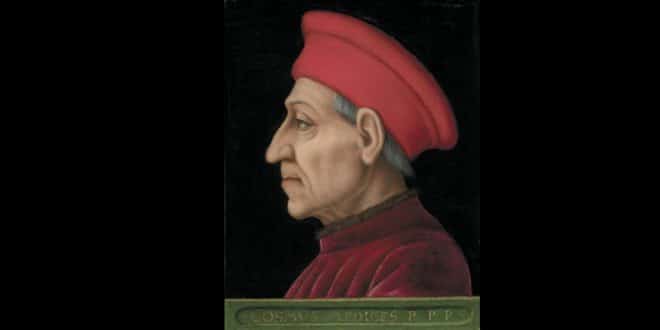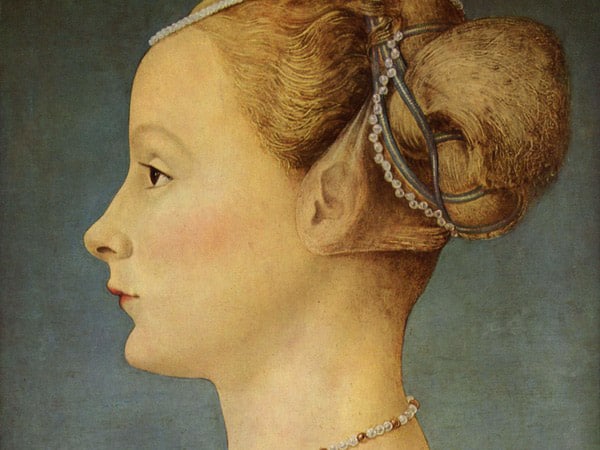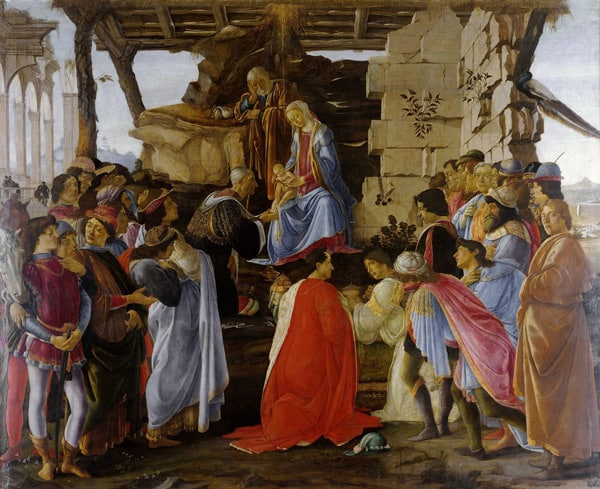Cosimo de’ Medici the Elder (Cosimo di Giovanni de’ Medici, Cosimo il Vecchio) – one of the most prominent figures of his time, possessed an extraordinary character and lived a vibrant, interesting, and long life.
His name is inseparably linked to the history of medieval Italy and all of Europe. He was the progenitor of the famous Medici dynasty, which earned him the nickname “the Elder” (or “the Elderly”), the wealthiest man, a merchant, banker, financier, and statesman who skillfully used his wealth to become a highly influential figure, playing a significant role in the economy, politics, and cultural life of the Florentine Republic.
Page Contents
Family and Education
Cosimo de’ Medici was born in 1389 in Florence. He was the eldest son of Giovanni di Bicci de’ Medici and Piccarda Bueri. The head of the family became a renowned Italian banker, going from a simple creditor to the founder of a financial empire. Thanks to his entrepreneurship, hard work, and his wife’s dowry, he established the Medici Bank in 1392, one of the most prosperous commercial enterprises in Europe. Cosimo’s mother, Piccarda Bueri, came from a noble lineage, an ancient aristocratic family, and was considered one of the first beauties of Verona.
The young man received a brilliant comprehensive education. He studied at the school of the monastery of Santa Maria degli Angeli, where he was taught philosophy, art history, exact sciences, and foreign languages. He was proficient in French, German, Arabic, and Hebrew. One of his teachers, and later a friend, was Roberto de’ Rossi, the foremost expert in classical literature, rhetoric, Latin, and Greek, who instilled a sincere love for ancient heritage. The upbringing played a significant role, with his father’s guidance influencing the character and destiny of Cosimo de’ Medici. Giovanni di Bicci taught his successor modesty and moderation, advised him to refrain from openly expressing his thoughts, avoid legal disputes and political arguments, and not to show pride and stubbornness.
Native Brother
Throughout his life, Cosimo de’ Medici felt an inseparable connection to his only younger brother, Lorenzo di Giovanni de’ Medici, who was born six years later. Giovanni di Bicci’s sons were never plagued by jealousy, they were not competitors, and they always remained a strong support and pillar for each other. They both participated in the family’s commercial (later political) affairs. Lorenzo was less proactive but assisted his brother in all his undertakings. He later became the progenitor of the younger branch of the Medici family, whose descendant was Cosimo I, proclaimed the first ruler of the Grand Duchy of Tuscany in 1569.
Marriage of Cosimo and Contessina
In 1416, at the age of 27, Cosimo married an Italian aristocrat named Contessina de’ Bardi, who belonged to the ancient and influential Florentine banking family. This marriage union was arranged at the insistence of Giovanni di Bicci and strengthened the position of the Medici clan. It is known that Contessina participated in managing the family’s financial affairs. She was a very modest, thrifty, and wise woman. She outlived her husband by 9 years.
Their Children
They had two children during their marriage: Piero (Piero di Cosimo de’ Medici), who acquired the nickname “the Gouty” (il Gottoso) due to an illness, born in 1416, and Giovanni (Giovanni di Cosimo de’ Medici), born in 1421. The younger son, who was seen as the successor of the family business, died at the age of 42, a year before his father’s death. In 1469, the great Medici dynasty would be continued by Piero’s son, 20-year-old Lorenzo the Magnificent (Lorenzo di Piero de’ Medici il Magnifico).
Finance and Banking
Even in his youth, Cosimo demonstrated himself as a brilliant merchant with excellent intuition, sharp wit, and entrepreneurial spirit. By the age of 30, he was already actively involved in his father’s commercial affairs and headed the family bank. In 1429, Giovanni di Bicci passed away, leaving his sons a vast fortune. In addition to lands and other properties, Cosimo inherited nearly 180,000 florins (Florentine gold coins) and became one of the richest men in Florence.
His business interests were very diverse. Together with his brother, he engaged not only in expanding the banking network (branches were opened in various parts of Europe, North Africa, the Middle East, and the Far East) but also in trade. The Medici family business monopolized and encompassed the following areas:
- Production and sale of wool and silk fabrics.
- Extraction of alum, used in the textile and tanning industries.
- Trade of valuable furs and scarce spices in Europe.
Engaging in extensive commercial activities necessitated entering the political arena. Such a role for the founder of the Medici clan proved to be very significant for Florence.
Political Life
Being intelligent, insightful, and proactive, Cosimo understood the importance of participating in political life. His father had prepared the ground for him: Giovanni di Bicci had a certain influence in Florence and played a significant role in lowering taxes for the people, which helped the Medici family gain supporters among the common citizens. As early as 1415 and 1417, Cosimo was elected for short terms as a member of the Florentine Signoria, the highest body of municipal self-government. Later, he became the leader of the People’s Party, which acted as an opposition force against the local patricians.
The real struggle for power began in the 1430s. The confrontation took place between the aristocratic and popular parties, specifically between two influential clans: the Albizzi and the Medici.
The fiercest and most open feud between the families occurred after the loss of the war between Florence and Lucca and Milan. Through intrigues and false accusations, the head of the aristocratic party, Rinaldo degli Albizzi, managed to have Cosimo imprisoned. There was even talk of a death sentence, but after lengthy negotiations, the city authorities issued a decree of exile for the Medici and their relatives from Florence for ten years.
In 1433, the family left their hometown and went to Padua (Padova), later relocating to Venice. Interestingly, when Cosimo left the boundaries of the Florentine Republic, the common people showed him their support, respect, and honor, while the Venetians received him not as a condemned exile but as a worthy statesman. While in Venice, Cosimo continued his active financial and political activities.
The rule of the Albizzi clan was short-lived. Mistakes in foreign policy and tax increases undermined the positions of the aristocratic party. In 1434, elections were held in the Florentine Signoria, resulting in the leadership positions in the city being occupied by opponents of the patricians. It was a complete failure for the Albizzi family. Cosimo returned to Florence a year after his exile, and his comeback was a true triumph.
Power in the Hands of the Medici
In 1434, the thirty-year “golden” era of Cosimo de’ Medici’s rule began. During his time in power, Florence experienced a period of political stability, as well as economic and cultural prosperity. The main achievements included:
- Resolving conflicts among representatives of different social classes in Florentine society.
- Implementing wise social policies towards common citizens, such as tax reduction, support during lean years, and more.
- Establishing peaceful relations with Milan, Naples, and Venice.
- Annexing certain neighboring territories.
- Increasing the prestige of the Florentine Republic and transforming it into a center of international politics.
- Developing the financial system, as well as maritime trade, commerce, agriculture, and silk production.
- Fostering a focus on education and culture, attracting the best minds in science and art to Florence.
It is interesting to note how Cosimo de’ Medici governed the republic. Concentrating actual and absolute power in his hands, he did not hold high titles and only served as the Gonfaloniere (head of the Signoria) three times, each for a two-month term. Yet, he remained the decisive figure, the “gray cardinal” in Florence’s political life until his death. The republican form of government gradually became nominal. Key state positions were given to loyal and devoted followers, while Cosimo himself preferred to stay in the shadows. Recognizing the power of capital, he effortlessly bankrupted and destroyed opponents or, conversely, attracted influential individuals to his side. Money became his primary political weapon. For example, the Medici extended loans to the Pope, the King of England, the Duke of Burgundy, and many other prominent figures.
Patronage
Cosimo de’ Medici was always a patron of humanists, artists, and writers, aiming to make Florence the center of intellectual life in Italy. He was one of the most generous patrons in Europe, acquiring valuable books, ancient Greek and Latin manuscripts, generously funding translations of classical works (including the works of Plato and Cicero), and commissioning renowned sculptors, architects, and painters. Cosimo provided support to many great creators of the Renaissance, including:
- Scholar, writer, and historian Leonardo Bruni.
- Writer and collector of ancient manuscripts Poggio Bracciolini.
- Art theorist, architect Leon Battista Alberti.
- Humanist thinker and Latin scholar Cristoforo Landino.
- Architect and sculptor Filippo Brunelleschi.
- Artist Filippo Lippi.
- Sculptor Donatello.
- Architect and sculptor Michelozzo di Bartolomeo.
During his rule, Florence underwent transformations: significant funds were allocated by the Medici family for the construction of temples, monasteries, shelters, and hospitals. Cosimo’s money was invested in the construction of the Cathedral of Santa Maria del Fiore, the reconstruction of the Church of San Marco, which also housed a public library, the refurbishment of the dormitory of the Santa Croce Monastery, the renovation of the Basilica of San Lorenzo, and many other architectural structures.
In 1462, at the initiative of the Medici, the Platonic Academy was established, headed by Marsilio Ficino, an outstanding philosopher, astrologer, humanist, and expert in ancient heritage. For 30 years, the Medici villa in Careggi, which became the center of Florentine Neoplatonism, hosted meetings of the finest representatives of science and art of the Renaissance. The works of ancient thinkers were studied, and discussions on philosophy, aesthetics, and religion took place.
Cosimo spent over 400,000 florins on charitable purposes and the development of public organizations, which was almost twice the amount of his inheritance upon his death.
The last years of life and death
In the twilight of his life, Cosimo de’ Medici faced numerous challenges. He deeply mourned the deaths of his younger son and grandson. The family business had to be handed over to Piero, who was inclined towards a secluded, spiritual life and distant from commercial and governmental affairs. On the political stage, Cosimo expended much energy, health, and time in quelling the dissatisfaction of opponents who rose against his sole rule over the republic. Despite being an untitled head of state, he continued to enjoy immense authority and respect among the common citizens.
Cosimo sensed the approach of death in the spring of 1464. Together with his wife, he moved to his beloved villa in Careggi, where he peacefully passed away on August 1st of the same year. The burial took place in the Church of San Lorenzo, the resting place of renowned members of the Medici clan. Although Cosimo had desired modest funeral rites, all the residents of Florence came to bid him farewell. By order of the government, the words “Father of the Fatherland” were inscribed on his tombstone, bearing witness to and expressing the genuine respect of the people that the wise ruler had earned during his lifetime.
Depictions in painting
According to contemporaries, Cosimo did not possess outward attractiveness and had ordinary physical features. He preferred modest clothing suitable for his position, was thin, of small stature, with rough facial features and an earthy complexion. Age-related ailments such as gout and arthritis had disfigured his figure and gait. The most famous portrayal of Cosimo is a profile portrait by the Florentine artist Pontormo (real name: Jacopo Carucci), painted over half a century after the founder of the Medici dynasty’s death.
The painting can be seen at the Uffizi Gallery (Galleria degli Uffizi), one of the oldest art museums not only in Florence but also in all of Europe.
Cosimo the Elder is also depicted as an old man, yearning to kiss the infant Christ, in the painting “Adoration of the Magi” by the renowned Sandro Botticelli.
In Giorgio Vasari’s “Lives of the Artists,” the main source of information on Renaissance creators, there is a detailed analysis of this artwork. It is considered one of the most vivid and accurate portraits of Cosimo.
TV Series
In October 2016, a multi-part TV series titled “Medici: Masters of Florence” was released, a collaboration between British and Italian filmmakers, consisting of 8 episodes.
Following the tremendous success of the first season, the series continued in October 2018. The role of Cosimo was played by Scottish actor Richard Madden. Audiences are thrilled by the vibrant and vivid historical drama, which eloquently narrates the story of medieval Europe and the intricacies of the fates of the powerful Medici family.
Interesting Facts about Cosimo de Medici
- Cosimo de’ Medici was born on September 27, 1389, in Florence, Italy. He was born into a wealthy banking family, the Medici, who played a significant role in the cultural, political, and economic development of Florence during the Renaissance.
- Cosimo de’ Medici was an influential patron of the arts. He supported renowned artists such as Donatello, Fra Angelico, and Filippo Brunelleschi, contributing to the flourishing of the Renaissance art movement.
- Cosimo de’ Medici established the first public library in Florence, known as the Medici Library (Biblioteca Medicea). This library housed a vast collection of books and manuscripts, fostering intellectual and cultural advancement.
- Known for his diplomatic skills, Cosimo de’ Medici played a crucial role in maintaining political stability in Florence. Through strategic alliances and negotiations, he ensured the Medici family’s dominance and influence in Florentine politics.
- Despite facing political challenges, Cosimo de’ Medici successfully ruled Florence as the de facto ruler for nearly three decades. His leadership and ability to navigate complex political dynamics earned him the title “Pater Patriae” (Father of the Fatherland).
- Cosimo de’ Medici was a staunch supporter of humanist ideals and education. He sponsored the education of numerous scholars and founded the Platonic Academy in Florence, promoting intellectual discourse and the study of classical literature and philosophy.
- Cosimo de’ Medici died on August 1, 1464, leaving behind a lasting legacy. His patronage of the arts, political astuteness, and contributions to education and culture played a pivotal role in the transformation of Florence into a leading center of the Renaissance.
 Italy for me From Italy with love
Italy for me From Italy with love




